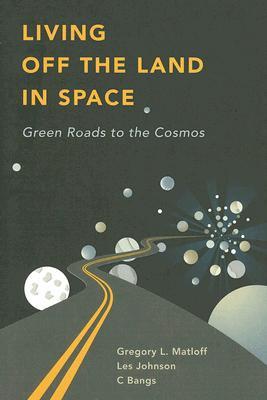By Bernd Henschenmacher
In Living off the Land in Space, Gregory Matloff, Les Johnson and artist C. Bangs discuss how mankind may colonize the Solar System and travel to nearby stars using energy and material resources provided by nature. The whole book is devoted to the ‘Living off the Land’ concept, which is introduced in the early chapters. Future space travelers, say Matloff et al., will use solar energy and mine the asteroids in order to reach other planets in our system and, later, stars like Alpha Centauri.
Given the huge distances involved and the difficulties of rapid transport from Earth, such methods are the only feasible way for mankind to leave its home. The authors draw on historical examples of colonization endeavors here on Earth to illustrate that living off the land is quite an old concept. Indeed, our species would still be confined to Africa if early humans had failed to use the resources they found along the way to new continents and islands.
After a short review of propulsion systems (Project Orion and Daedalus, interstellar ramjets, antimatter drives and even space warps), the authors focus on those concepts that may be available in the not too distant future. The reader will find chapters dealing with ion, solar thermal and chemical propulsion as well as space tethers and solar sails as methods of pushing into deep space. All have the advantage of requiring no fundamental breakthrough in physics to achieve the desired result.
Every propulsion system that has ever been envisioned for interstellar travel (even anti-gravity devices, the Zero Point Energy concept and the like are mentioned) is explained in an easy to understand way, laden with but a small amount of mathematics. Science fiction enthusiasts may be disappointed to read here that manned interstellar travel will probably take millennia and that warp drives are essentially impossible, but the authors’ admonition that breakthroughs happen leaves the matter open.
Nevertheless, the goal of the book is to provide a realistic view of what might be possible with technologies that are accessible in the near future. A wealth of references at the end of each chapter point the way to further resources. Living Off the Land in Space should satisfy anyone who wants to learn more about space colonization and the propulsion methods that will make it happen.



I see in the table of contents that they talked about gravitational assists.
did they talk about low energy orbital transfers / the interplanetary transport network ? This is where the gravitational topography of the multiple planets and objects in space are used for low energy and low cost transfers between planets.
I describe using this as a cheap way to win the google lunar lander prize
http://advancednano.blogspot.com/2007/09/outline-of-how-to-win-google-lunar.html
I also believe that Nasa should use this method to send a large number of robotic vehicles to the Moon and other locations so that we have robots prepping the land for people to eventually live. Making solar cells and mining materials on the moon etc…
Robots do not have to go fast they can go slow and cheap.
In a lot of cases we should send people and cargo and robot separately. Like now we have people on planes with only a few carry on bags and checked bags, but most commerce sends things over weeks via container ships.
Brian, yes, the Living Off the Land in Space book does get into low energy orbital transfers in the context of solar/electric propulsion. Very efficient way to go, and ideal for slow ‘space tugs’ lugging up equipment and flown on robotic missions.
I think I have to apologize for not mentioning the gravity assists in my review. Futhermore solar thermal and nuclear thermal propulsion are mentioned in the book, ae well as terraforming, suspended animation and Gerald K. O’ Neil’s space cities.
Review: Crossing the Threshold
How can we take advantage of the virtually boundless energy and material resources in the solar system? Jeff Foust reviews a book that offers a series of proposals to accelerate humanity’s expansion into and utilization of space.
http://www.thespacereview.com/article/1724/1